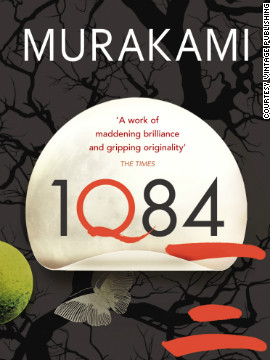1Q84 - Haruki Murakami
Review:
If you can't understand it without an explanation, you can't understand it with an explanation.
That's what the world is , after all: an endless battle of contrasting memories
If you're already a Murakami fan (as I admittedly am), you will not be disappointed with 1Q84. It has everything it takes to be a Murakami book. That said, I think it's a tiny bit more fluffy than my last read, "Kafka on the Shore", especially towards the end.
OK, this review is going to be more detailed than the regular ones, so here be spoilers. You have been warned.
The story revolves around Tengo, a brilliant student, athletic personality turned writer and cram school teacher. Aomame is Tengo's classmate, now lost love and a deadly assassin. Tamotsu Fukada (the Leader) is the supposed Bad Guy, who's daughter Fuka-Eri (or at least her Dohta) runs away from their cult, Sakigake's HQ. Komatsu is Tengo's mentor who hatches the plan of ghost-writing Air Chrysalis which was originally written by Fuka-Eri. Aomame, along with the Shizue Ogata (the dowager) and her right-hand man Tamaru, she plans to eliminate the Leader and put an end to their cult.
Let's recall the chain of events:
- Fuk-Eri writes the weird story about Little People.
- Komatsu persuades Tengo to ghost-write Air Chrysalis.
- The Little People spring to life and attack the dowager's dog.
- Tengo begins writing his own book. His creativity is suggested to be sparked after co-writing Air Chrysalis.
- Aomame is drawn into another world, 1Q84.
- The dowager and team hatch the plan to assassinate Leader.
- Aomame successfully completes her mission but something strange happens that night.
- Aomame is on the run and goes into hiding.
- Ushikawa enters the scene and spies on Tengo.
- Tengo and Fuka-Eri also go into hiding.
- Tengo goes to the hospital to look after his ailing father.
- Ushikawa pursues Tengo, stumbles upon Aomame.
- Tamaru finds out Ushikawa and handles him.
- Tengo and Aomame re-unite and go back to 1984.
There are multiple suggestions throughout the book that the world might not be real and that it's all just made of paper, a sort of stage setup. So, my hypothesis is this:
- The Little People are the inversion of Big Brother - a metaphor for gullible populace?
- Fuka-Eri, being the Leader's daughter has some power over the Little People.
- By co-writing Air Chrysalis with Tengo she weakens the power of Little People.
- Seeing the effect of powerful writing, Tengo begins to write a story of his own.
- The story's power brings Aomame into 1Q84 and sets the course of her actions.
- The Little People work against Tengo's writing to prevent Aomame from meeting him.
Of course, there are still a lot of open questions that'll keep haunting me for days. A few plot devices are worth mentioning though:
- The use of animals as alter-egos. E.g crow, owl.
- The NHK fee collector as a metaphor for retribution. He haunts everyone who is in hiding - Aomame, Tengo and Ushikawa.
- The flaws in the characters which make them more human and relatable.
- The self-referential elements - Chekhov's Gun
- The various religions - Sakigake, the Society of Witnesses and the way in which their ideologies are portrayed
If you haven't read Murakami, you might find this book weird and lacking in explanation. However, the contrasting and lively characters, the absurd plot devices, metaphors and symbolism more than make-up for it.
4/5 - A bit fluffy, but entertaining
